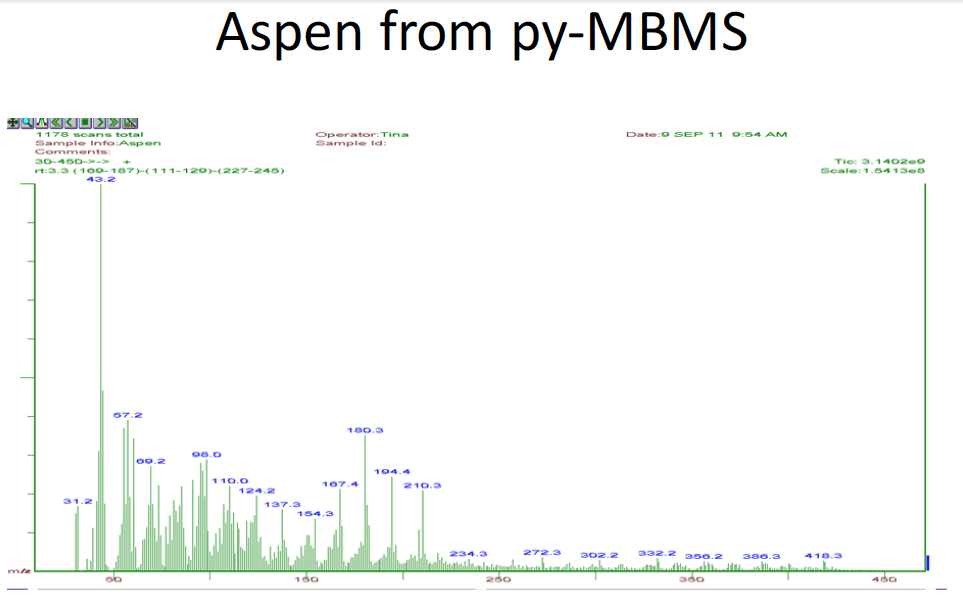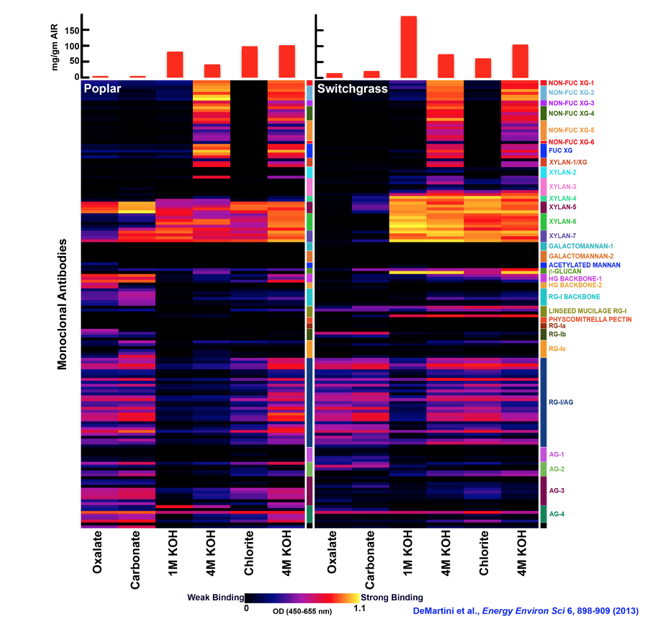Plant Carbohydrates
Isolation/Purification
Separation of pure cell wall components.
We offer the following services for complete characterization of plant polysaccharides:
Purification and isolation– we can purify plant polysaccharides from other plant components based on their charge or molecular weight by using size-exclusion chromatography (SEC) and alcohol precipitation. We utilize various MW range FPLC columns and detection techniques (UV, RI, ELSD) to separate polymers from oligosaccharides. The amount of sample required for complete analysis depends on the scope of project and complexity or purity of the starting material.
Polysaccharides Structure
- Glycosyl composition – we can provide qualitative and quantitative monosaccharide composition analysis. At least 100-500 micrograms of sample is used for this analysis.
- Glycosyl linkage – we apply methods of partially methylated alditol acetates (PMAA) with additional modifications required for determination of uronic acids or unusual carbohydrate substituents. 200mg up to 1mg or higher amounts of sample is required for linkage analysis.
- Molecular weight determination – Size Exclusion Chromatography (SEC). SEC analysis provides information on molecular weight distribution of complex polysaccharide or oligosaccharide mixtures. 200mg-1mg or higher amounts of sample is required for linkage analysis.
- 1D- and 2D-NMR-spectroscopy – 1D (1H, 13C) and standard 2D homo- and heteronuclear nuclear magnetic resonance (including inter alia 1H-1H-COSY, TOCSY, NOESY, ROESY, 1H-13C-HSQC, H2BC, HSQC-TOCSY, and HMBC) is an extremely powerful technique for determination of carbohydrate sequence and structure of plant poly- and oligosaccharides. It also helps to evaluate sample quality, – α/β – anomeric configuration of glycosyl residues, and quick assessment of the nature of purified polysaccharide. Information on sample requirements can be found at: NMR Facilities
- Enzymatic digestion – Depolymerization or cleavage of plant polysaccharides helps to generate oligosaccharides suitable for structural characterization by mass-spectrometry (MALDI-TOF MS or ESI-MS) and 1D and 2D NMR-spectroscopy.
- High-Performance – Anion Exchange Chromatography (HPAEC) – Separation of plant derived oligosaccharides based on their mass to charge ratio allow identification and quantification of lower oligomers (up to DP8-10) based on availability appropriate reference standards.
- Determination of absolute configuration of glycosyl residues – ‘D’ and ‘L’ absolute configuration of individual glycosyl residues can be determined by acid-catalyzed derivatization with optically pure 2-butanol, followed by per-O-trimethylsilylation and GC-MS analysis. Identification of the D and L forms is made by comparison of retention times the standard D or L monosaccharides. A minimum of 200-500 micrograms of carbohydrate is required, more if available.
- Plant Cell Wall Glycome Profiling by high throughput ELISA automated system – Glycome profiling, which is an immunological technique for rapid characterization of plant cell wall/biomass samples that was developed in Dr. Michael Hahn’s laboratory at the CCRC. This semi-quantitative analytical technique takes advantage of a large and diverse toolkit of monoclonal antibodies (mAbs) directed at each of the major non-cellulosic plant cell wall polysaccharides, except rhamnogalacturonan II. The mAb collection includes multiple antibodies against epitopes on xyloglucans, xylans, homogalacturonans, rhamnogalacturonan I, mannans, and arabinogalactans.
Hemicellulose/Cellulose
We offer analyses for quantification of cellulose and hemicellulose in lignocellulosic biomass providing expertise in:
- Fractional Extraction of Hemicelluloses – Cellulose and some associated polymers will remain insoluble after extraction of hemicelluloses. Isolated hemicellulose fractions are used for glycosyl composition, glycosyl linkage (PMAA), MW distribution (SEC), and structure elucidation
- Phenol-Sulfuric Colorimetric Assay – For cellulose residue after removal of hemicelluloses. Phenol-Sulfuric assay is a basic colorimetric assay to quantify neutral sugars in polysaccharides or mixtures. Sample amount required: at least 100mg of the complex mixture.
- Glycosyl Composition and Linkage – We can provide qualitative and quantitative monosaccharide composition analysis (At least 100-500 micrograms of sample is used for this analysis). In addition permethylation analysis resolves glycosidic linkages between sugar residues and is very useful tool in characterization of complex plant glycans 200mg up to 1mg or higher amounts of sample is required for linkage analysis.
- 1D- and 2D-NMR spectroscopy – 1D and standard 2D homo- and heteronuclear nuclear magnetic resonance spectroscopy (NMR) is an extremely powerful technique for determination of carbohydrate sequence and structure of plant poly- and oligosaccharides. It also helps to evaluate sample quality, – α/β – anomeric configuration of glycosyl residues, and quick assessment of the nature of purified polysaccharide. Information on sample requirements can be found at: NMR Facilities
- Glycosyl Composition – We can provide qualitative and quantitative monosaccharide composition analysis of the biomass (At least 100-500 micrograms of sample is used for this analysis).
- Glycosyl Linkage – Permethylation analysis is the classic method establishing the position of glycosidic linkages between sugar residues and is very useful tool in characterization of complex plant glycans. We apply methods of partially methylated alditol aceteates (PMAA) with additional modifications required for determination of uronic acids or unusual carbohydrate substituents. 200mg up to 1mg or higher amounts of sample is required for linkage analysis.
- Polysaccharide and oligosaccharide sequencing by NMR-spectroscopy – Complete set of 1- and 2-D NMR experiments is required in order to determine the full sequence of polysaccharides for complete structure elucidation. Information on NMR sample requirements can be found at: NMR Facilities
- Size-exclusion (SEC) HPLC methods with variety of post-column detection- SEC analysis provides information on molecular weight distribution of complex polysaccharide or oligosaccharide mixtures. 200mg-1mg or higher amounts of sample is required for linkage analysis.
- Fractionation and purification of oligo- and polysaccharide – A variety of HPLC methods such as size-exclusion, ion-exchange chromatography is used. The purification requires higher sample amounts about 10-100 mg depending on the nature of the sample.
- Mass-spectrometric techniques include MALDI-TOF/TOF MS, LTQ-ESI MS- These techniques will provide information on molecular weights. Samples must be pure from surfactants and contaminants.
- Plant Cell Wall Glycome Profiling by high throughput ELISA automated system – Glycome profiling, which is an immunological technique for rapid characterization of plant cell wall/biomass samples that was developed in Dr. Michael Hahn’s laboratory at the CCRC. This semi-quantitative analytical technique takes advantage of a large and diverse toolkit of monoclonal antibodies (mAbs) directed at each of the major non-cellulosic plant cell wall polysaccharides, except rhamnogalacturonan II. The mAb collection includes multiple antibodies against epitopes on xyloglucans, xylans, homogalacturonans, rhamnogalacturonan I, mannans, and arabinogalactans.
Fungal/Glucans
Fungal cell wall polymers, glycolipids and exopolysaccharides
Fungi synthesize an array of various polysaccharides and glycolipids different from prokaryotes: cell wall polymeric glucans (e.g., β-(1→3)-glucan, β-(1→6)-glucan, a-(1→3)-glucan, a-(1→4)-glucan), mannans and chitin. In addition, fungi are known to produce extracellular polymers (e.g galactoxylomannan or glucuronoxylomannan) and intracellular glycogen. Fungal glycolipids are mostly represented by glycosphingolipids that consist of one or more monosaccharide residues linked to ceramides (glycosylceramides). Depending on a subject of a study we offer help with:
- Extraction and purification of crude fungal glycolipids and polysaccharides from cell walls or media via mechanical, chemical or enzymatic cell disruption or liquid-liquid extraction and purification and enzymatic release of specific glycans by nucleases, protease, exo- and endo-glucosidases) and by various chromatography techniques (SEC, HPLC, HPAEC and TLC).
- Characterization of fungal polysaccharides and glycolipids by GC-MS analysis of glycosyl or fatty acid derivatives, and with high resolution mass spectrometry including MALDI-TOF, electrospray ionization (ESI-MS) and structural characterization by nuclear magnetic resonance spectroscopy (1D and 2D NMR).
Lignin Analysis
Analytical services at CCRC offer combination of following chemical and instrumental analysis for profiling lignocellulosic biomass and pretreated biomass:
Pyrolysis Molecular Beam Mass Spectroscopy (py-MBMS) and Pyrolysis Gas Chromatography Mass Spectroscopy (py-GCMS) – The Complex Carbohydrate Research Center has installed a pyrolysis molecular beam mass spectrometer (py-MBMS) and a pyrolysis gas chromatography mass spectrometer (py-GCMS) for analysis of plant cell wall constituents and lignin structure.
We will be using py-MBMS to analyze the lignin and C5 and C6 glycosyl compositions in the plant cell wall. The instrument consists of a commercially available pyrolysis unit and autosampler coupled with a molecular beam mass spectrometer. Total lignin content, p-hydroxyphenyl (H), syringyl to guaiacol (S/G/H) ratios can be estimated directly from the spectra. Thus, we can easily identify the plants with different cell wall composition in a large group of samples using multivariate analysis. The py-MBMS will produce a figure-printing method to analyze lignin monomers without a need to fully interpret the mass spectrum. The computer-assisted software (Chemometrics) will be used to assist in data mining and classification of the samples.
The py-GCMS consists of a commercially available pyrolysis unit and autosampler coupled with gas chromatography mass spectrometer, and it will be used to analyze/characterize the structure of the lignin in plant cell walls in more detail. Comparing the peaks for the same sample from py-MBMS and py-GCMS, we would be able to understand lignin structure more efficiently.
Glycome Profiling
Plant Cell Wall Glycome Profiling by high throughput ELISA automated system- glycome profiling, which is an immunological technique for rapid characterization of plant cell wall/biomass samples that was developed in Dr. Michael Hahn’s laboratory at the CCRC. This semi-quantitative analytical technique takes advantage of a large and diverse toolkit of monoclonal antibodies (mAbs) directed at each of the major non-cellulosic plant cell wall polysaccharides, except rhamnogalacturonan II. The mAb collection includes multiple antibodies against epitopes on xyloglucans, xylans, homogalacturonans, rhamnogalacturonan I, mannans, and arabinogalactans.
Absolute Configuration
- The absolute configurations of monosaccharides are determined by GC-MS analysis. Identification of D and L forms is made by comparison of retention time to standard D and L monosaccharides.
- Absolute configuration (D or L) of Monosaccharides
- Purpose: Determination of the absolute configuration (D or L) of monosaccharides
- Amount of sample required for analysis: A minimum of 200-500 micrograms of carbohydrate is required, more if available.
- Methods used: The absolute configuration of monosaccharides can be determined by acid-catalyzed derivatization with optically pure 2-butanol, followed by per-O-trimethylsilylation and GC-MS analysis. Identification of the D and L forms is made by comparison of retention times the standard D or L of monosaccharides.




